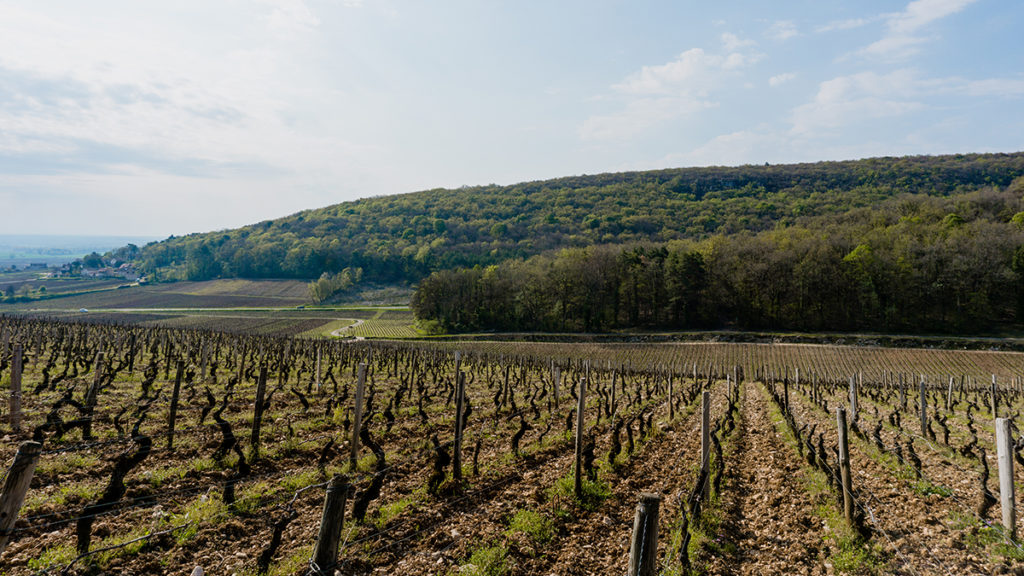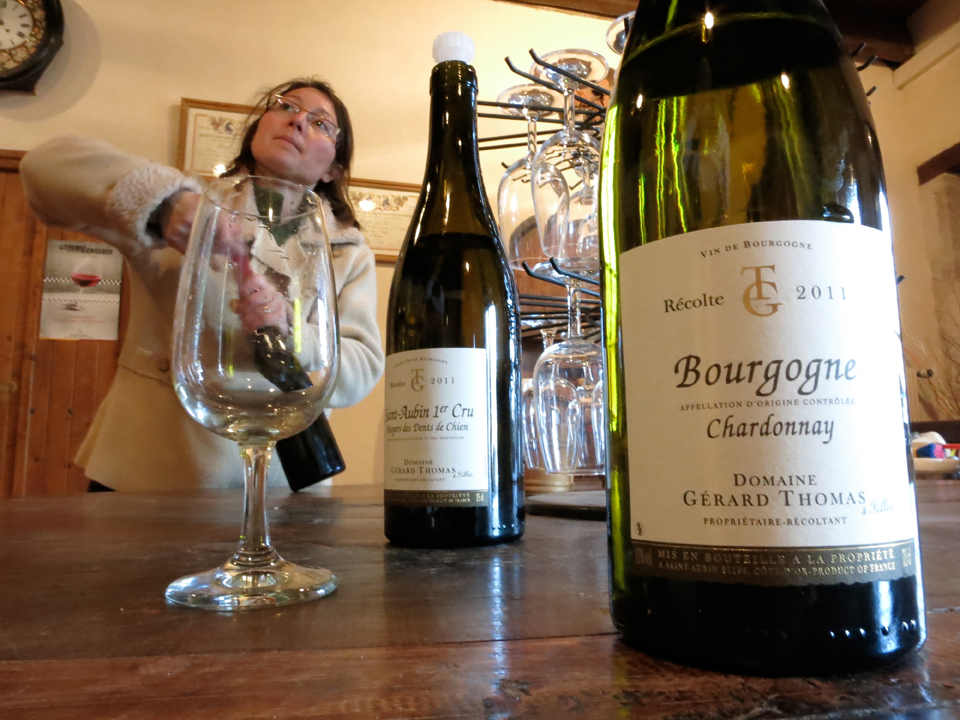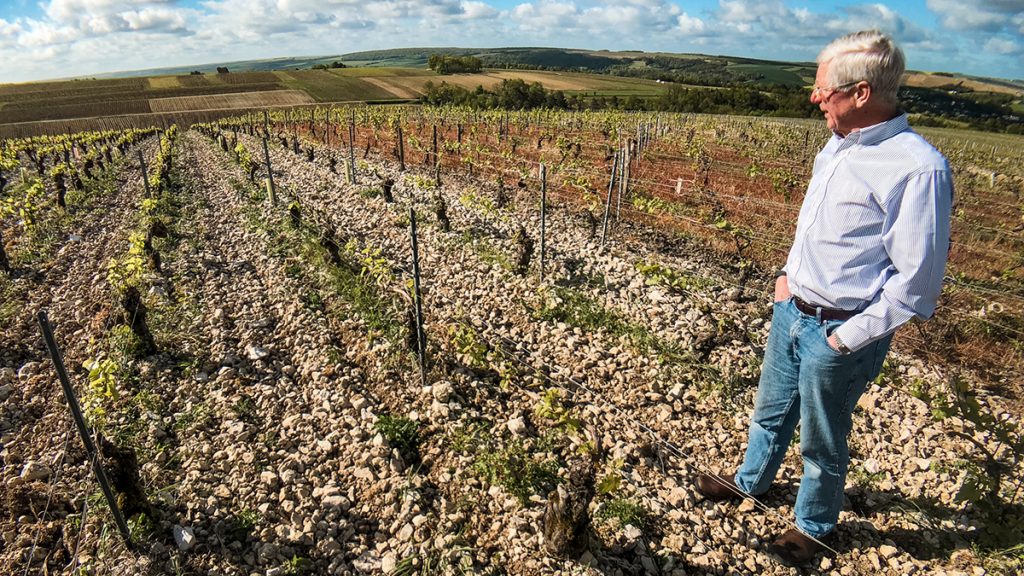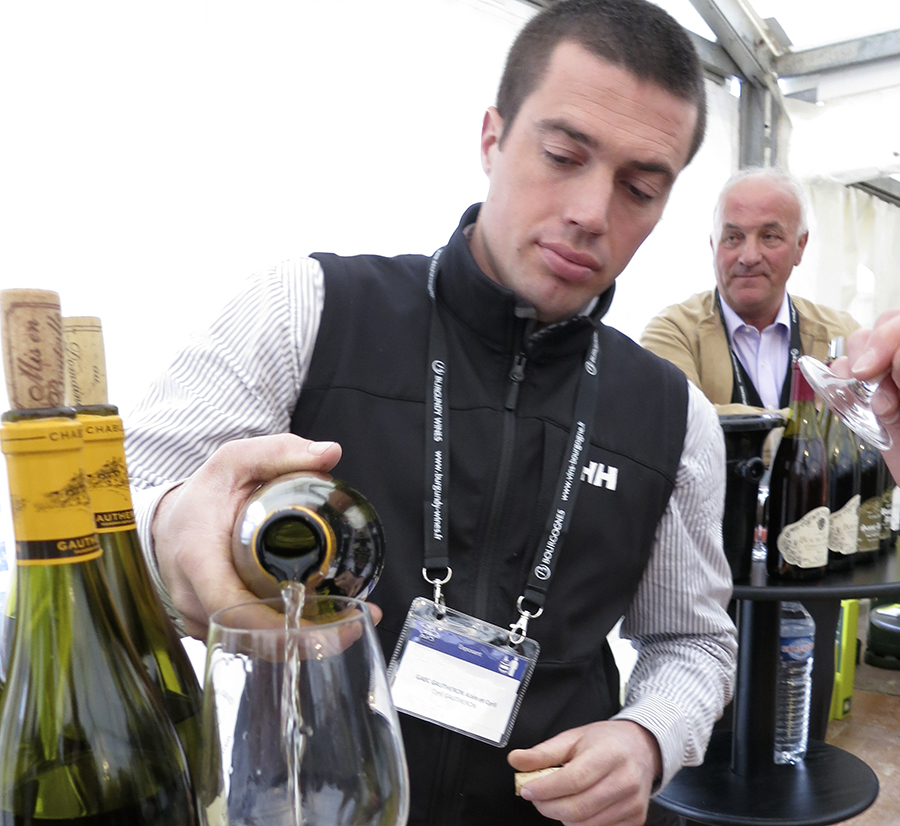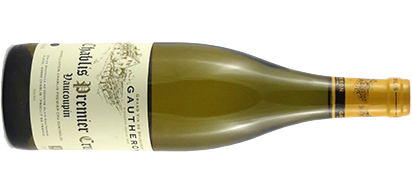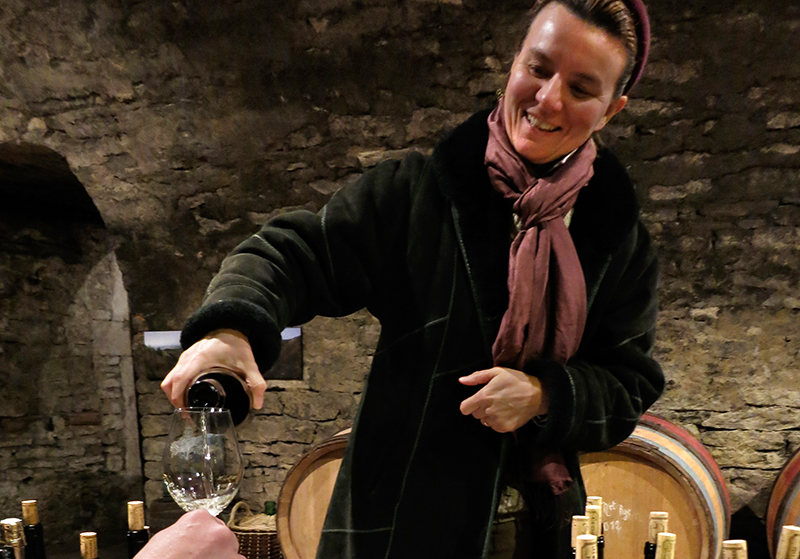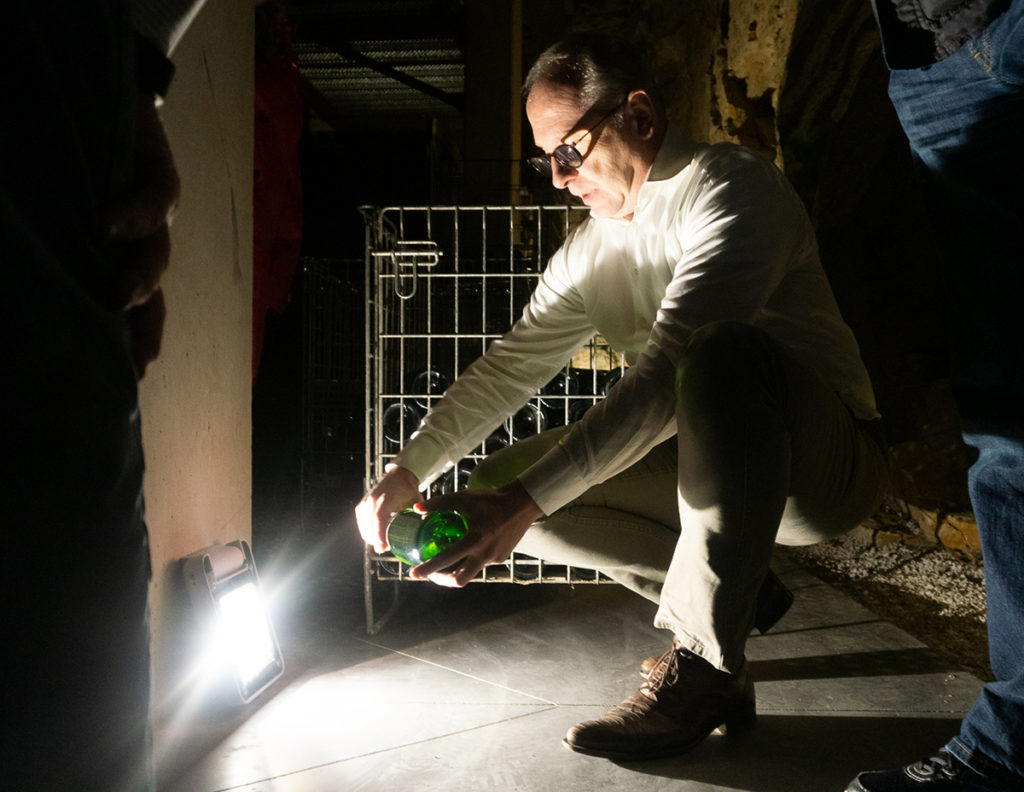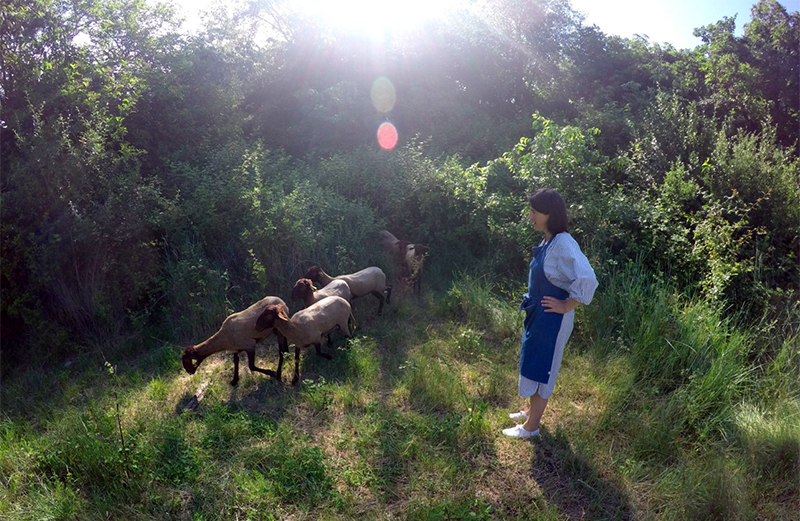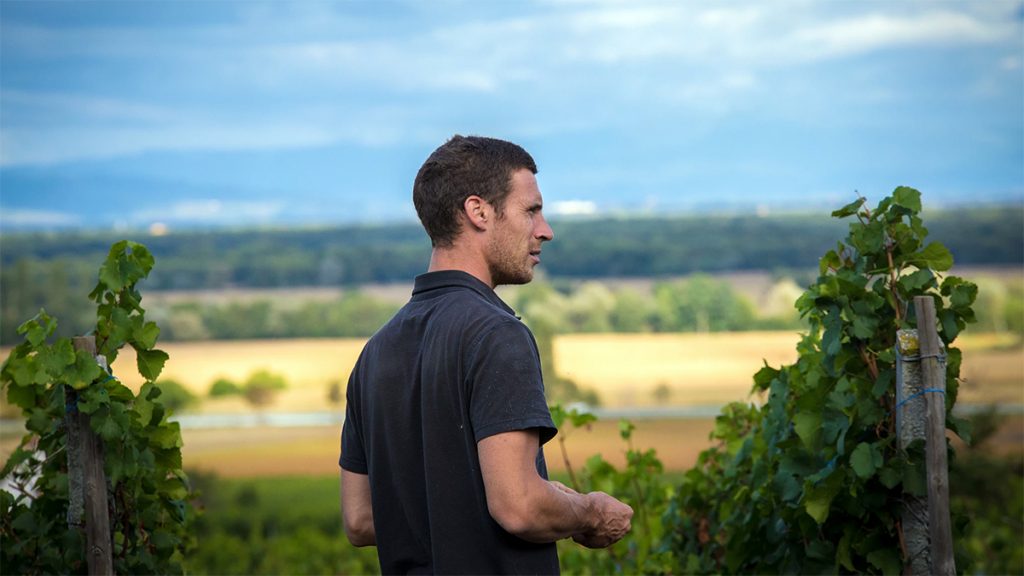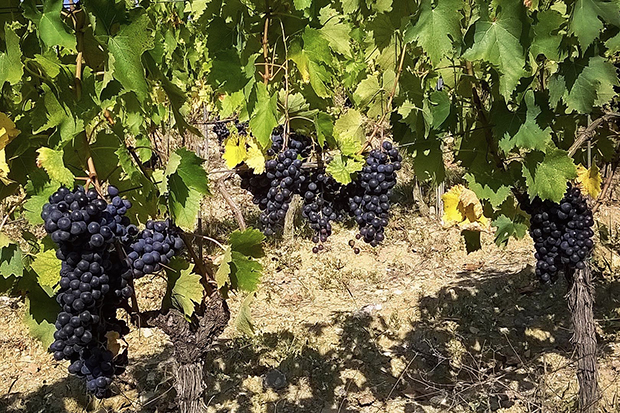January is usually a quiet time in the vineyards of France, devoted in many places to “la taille,” vineyard work to prune the previous year’s growth and to prepare the vines for the coming growing season. At least it’s naturally distanced, so the current Covid wave isn’t likely to interrupt this critical task. For our part, we are itching to get back among the vines and to taste wines in the cellars of the producers, seeing them where they are best seen and renewing old friendships — not to mention sampling the many pleasures of French cuisine. We have our reservations, and we are watching the latest sets of restrictions come and go, with fingers firmly crossed. In the meantime, we are excited about what’s on offer in January Futures. The wine from Poggerino, our sole Italian producer, is at least as good as ever, and there are many great choices from France. We have one last Futures offering of the superb 2019 red Burgundy from the Côte de Nuits. Also from Burgundy, there is sparkling wine and two offerings of white Burgundy from the 2020 vintage, one from Chablis and the one from the Côte d’Or; as well as 2019 white Burgundy from one of the Côte de Beaune’s top winemakers. In the Alsace you can choose among dry, sweet, white and orange wine. There is natural red from the Languedoc, and a whole new list of reds from Bordeaux’s left bank. We hope that there will be something in this offering for every taste and budget. If you find anything of interest, please fill out the order form linked here in case or half-case lots and submit it by the Order Deadline of Sunday, January 30. We will contact the producers and place the orders immediately thereafter. JUMP TO SECTION
Couvent
Thomas
Gautheron
Lestimé
Picamelot
Bordeaux
Foulaquier
Gross
Poggerino
January Futures
Order Deadline: 1/30
Domaine du Couvent
Gevrey-Chambertin, Burgundy
We are pleased to offer one more opportunity to acquire 2019 red Burgundies. As you might remember, the Domaine des Varoilles changed hands last year. Winemaker Gilbert Hammel retired after the 2019 vintage and has been replaced by Philippe Cheron, a well-established winemaker in the Côte de Nuits whose family owned the Varoilles vineyards years ago. Cheron has combined his properties under a new name, the Domaine du Couvent. As those of you who bought the Clos de Vougeot 2019 last fall know, the happy result is that we now have access to more excellent wines from the Côte de Nuits. At the regional level, we very much liked the Bourgogne Pinot Noir “Les Jumelles” 2019. It offers a lovely, expressive nose of pleasant berry fruit on the fruit noir rather than the fruit rouge side. It fills the mouth and coats the palate nicely for a wine of its level. Its tannins are ripe, providing a pleasant definition at the end of the palate. It’s a very good value from a terrific vintage. At the village Gevrey level, we were very impressed with the Clos du Couvent 2019. It’s a monopole located just in back of the domaine, once an old convent in the heart of the town of Gevrey. Its dark, briary fruit nose arrives with just a touch of mint alongside. There is plenty of extraction, good freshness, and the potential for many impressive glasses down the road. Writer Bill Nanson (“The Burgundy Report”) called this wine “silky and concentrated,” and felt that it successfully blends power and elegance. We would have loved the Chambolle-Musigny “40 Ouvrées” 2019 even without the charming name, which comes from an ancient measurement of vineyard area. An “Ouvrée” was the amount of vineyard that a worker (an “ouvrier”) could tend in a day. It’s made from a blend of twelve different village level plots from across the appellation – the resulting wine is an expression of the appellation as a whole. As you might expect, it’s classic Chambolle, elegant and seductive. Jasper Morris awarded 89-92 points, finding it “beautifully round and very stylish.” Vinous’s Neal Martin praised this wine’s “delicate but precise bouquet of perfumed strawberry and rose petal scents,” as well as its “smooth and succulent” palate. We can’t improve on his final comment: “Very sensual.” The 2019 Gevrey-Chambertin 1er cru “Clos des Varoilles” was vinified by Gilbert Hammel and bottled by Philippe Cheron. It is an excellent vintage for the wine, which is as always a big wine with lots of body, mouthfilling and rich. The fruit is dark and lovely, with an earthy mineral line and a persistent finish. Nanson writes: “a flavour that melts and slowly fades over the palate…Delicious and complex wine with a nervosité… Excellent again.” Finally, there is the Grand Cru that came to Cheron from the Domaine des Varoilles: the Charmes-Chambertin 2019. It is unquestionably a wine of Grand Cru density and intensity, if in a charming, elegant way rather than bold and muscular. Dark fruit and oak come through the nose along with an earthy minerality. Neal Martin praised its “lovely, very well defined bouquet of dark cherries, sous-bois and dark chocolate scents.” This wine will need time in the cellar, but it is very much of Grand Cru quality and should handsomely repay keeping. 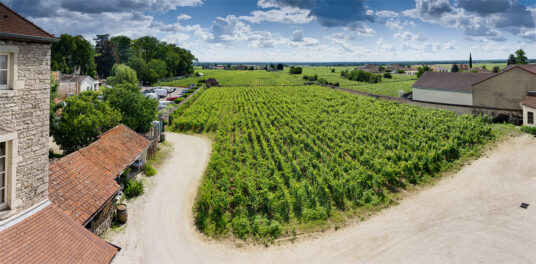
Gérard Thomas
St-Aubin, Burgundy
The 2020 vintage is an excellent one for white Burgundy. Analysts have been surprised by the robust levels of freshness and the potential for aging despite the hot growing season. This is very much the case at the Domaine Gerard Thomas, where we were delighted by the wines across the board. Their wines are all elegant in 2020, with a larger-than-usual dose of energy. That means that they may peak a little later than they often do, but patience will be rewarded in enhanced complexity and good longevity. The 2020 Bourgogne Chardonnay is brisk and bright, with a distinct line of salinity nestled alongside the fruit. The oak lies more in the background than usual, and pleasantly so. It’s dry and sophisticated, with an attractive creaminess of texture. This is a serious Bourgogne, and while it will be delicious for drinking as soon as it arrives, it is likely to improve for over a year. The 2020 St. Aubin “Champ Tirant” may be the best vintage we have seen of this wine. The nose offers a lovely blend of oak and fruit. In the mouth there is plenty of energy, with a touch of grape skin and Puligny-like supporting acidity front and center; which then melts into something rounder and more complex. The balance is excellent, and there is very good persistence and a complex finale. This is first-rate Champ Tirant, resembling a premier cru more than a village wine. The premier cru St. Aubin “Murgers des Dents de Chien” 2020 is very classy as usual. Like the Champ Tirant it is brisk up front, then rounds out nicely as it develops in the mouth. Most striking is its length, which goes on for some time with a lovely lingering blend of oak and fruit. Like the other 2020s from Thomas, this will require a bit longer to peak than it usually does, but it is definitely a first-rate Côte d’Or white Burgundy. The Puligny-Montrachet 1er cru “La Garenne” is another winner in 2020. It has the typically quiet nose of a just-bottled Puligny, and the supporting acidity is apparent; but equally apparent is the intensity and depth of an excellent vintage. This is a “masculine” Puligny 1er cru that will require some time to integrate and round out; but the elegance will undoubtedly come, and the wine should turn heads in a few years.
Domaine Gautheron
Chablis, Burgundy
As you might expect, the 2020 vintage was kind to Chablis as well as to the Côte d’Or. The Domaine Gautheron, our producer of more classically styled Chablis (no or minimal oak), for whose wines our stock has been sold out for months, had a very good year. The Petit Chablis seems to have been elevated by the vintage. It always provides good value in versatile, unoaked Chardonnay, but this year it is particularly so. The 2020 Petit Chablis is more substantial than usual, with good intensity joining the typical pleasant, bright nose of lemony fruit. It opens fresh, then resolves into a rounder mouthfeel. Though it should shine most brightly when served with fruits de mer, it will pair easily with all sorts of dishes calling for a white. It will also drink nicely on its own. The 2020 Chablis (our usual purchase at the village level, the Chablis Vieilles Vignes, isn’t in the bottle yet) is excellent. There’s considerably more here than in the Petit Chablis, with white peaches and other orchard fruit joining the lemon. The nose is a bit softer (less punchy) than the Petit Chablis, and there is noticeably more volume in the mouth. With a longer finish, it’s a more complete wine. At the premier cru level we have two suggestions. First, our longtime staple Vaucoupin 1er cru is terrific in 2020, and a definite step up from the village level. It offers a riper and more complex nose (dry peach here, too) with dried flowers and stones. There’s more volume in the mouth, and more roundness. There is more persistence and a longer finish too in this elegant, dry, fruit-driven wine. It’s a versatile wine that will pair effortlessly with all sorts of dishes. Our other idea in premier cru is Fourneaux 1er cru. The 2020 shows a very expressive nose, with the orchard fruits dominating the lemon. In the mouth a mineral punch mixes in with the fruit, making for a persistent palate and a long finish. There’s more sucrocité (feel of sugar in the mouth, but without sweetness) than in the Vaucoupin, and it’s a beat longer. The balance and tension are perfect. Choosing between Fourneaux and Vaucoupin is a matter of personal taste, but you won’t go wrong with either wine – both are focused, vibrant, flat-out delicious Chablis.
Caroline Lestimé
Chassagne-Montrachet, Burgundy
All of the winemakers we work with in Burgundy are grower-producers, meaning they farm their own grapes and produce their own wine. But over the last few years of severely diminished yields, we’ve seen several winemakers add “negociant” operations, making additional wine with purchased grapes under another label. These cuvées often put winemaker skill on display, and such is the case with the wines of Caroline Letsimé. Though we no longer offer Caroline Lestimé’s brilliant wines under her traditional Jean-Noël Gagnard label through our regular channels, she’s offered us two of her “negoce” cuvées this year, and they’re terrific. One comes from humble terroir and the other from a famous plot, but both show off Caroline’s technical cellar chops, and carry the signature glossy Gagnard character. First, a 2019 Savigny-les-Beaune – that’s right, Savigny. No, it’s not really near Chassagne (it’s up a side valley west of the city of Beaune), and it’s not an appellation we’ve ever offered before. But this wine was just terrific, and at an approachable price point. The nose is bright and perfumy, with lemon, stones and faint herbs. The mouth shows beautiful sucrocité, with a sleek round texture that finishes vibrant and fresh. As with all of Caroline’s wines, the interplay of oak, fruit and earth is seamless. With its excellent freshness we expect this to drink well for a number of years. Tasted blind we’d have placed it in St-Aubin or even Meursault. It’s easily the best Savigny-les-Beaune we’ve ever had, and will make any fan of the Gagnard style smile. And second, something from more familiar territory. The premier cru “Maltroie” vineyard lies in the center of the town of Chassagne-Montrachet, just feet from the Gagnard domaine. It produces regal, classic Chassagne, showing depth and golden richness. While this cuvée doesn’t quite match the splendor of the Clos de la Maltroye under the JN Gagnard label, it comes with friendlier pricing, and an extra two years of bottle age. The 2017 Lestimé Chassagne 1er cru “La Maltroie” is remarkably fresh and youthful after two years in the bottle. The nose is pretty and sophisticated, with notes of white flowers and hazelnut. The mouth is deep and powerful, every bit a premier cru – look for notes of baked lemon, silky sleek texture, and a long vibrant finish.
Maison Picamelot
Rully, Burgundy
Champagne’s pricing and re-corking mechanics mean most people don’t enjoy it regularly. But sparkling wine is ageworthy, versatile, and remarkably food-friendly — restricting your bubbles intake to Christmas and weddings means you’re missing out on a world of good wine. The solution to this problem is a $6 stopper and Crémant de Bourgogne. Good Crémant de Bourgogne offers an attractive relationship between price and quality. Our source for that is in the Côte Chalonnaise: Rully’s Maison Louis Picamelot. The Wine Advocate’s William Kelley writes that Picamelot “produces some of the best sparkling wines in Burgundy,” and “makes a persuasive case for taking the genre more seriously.” Philippe Chautard, the grandson of the founder, has taken the enterprise to a new level, transforming an old quarry on the edge of the town to a large underground cellar. This lets him give his crémants the time in the bottle he feels they need to develop their full complexity. It’s hard to pick a favorite here, so we’re suggesting five cuvées, all excellent values at under $350/case. First, Picamelot’s “Les Terroirs” Brut NV. A blend of Burgundy’s four grapes – Pinot Noir, Chardonnay, Aligoté, and Gamay – this delightful wine is a tremendous value. The nose is dry and classy, with notes of green apple, bread dough, and a pleasant nuttiness. It’s ripe and round in the mouth, lovely and full, and very gourmand. At under $20/bot through Futures, this is a no-brainer for weeknight bubbles. For something just as tasty but a bit more colorful, consider Picamelot’s Crémant Rosé Brut NV. This cuvée is pure Pinot Noir, on the skins just long enough to add a pleasant texture and attractive hue. The nose is more floral with notes of tulips and strawberries – the mouth is dry but fruit-forward with a hint of chalk. There’s a delicious texture here from the skin contact, and while this is lovely on its own, we think it’d make a great match for a plate of springtime appetizers. Picamelot’s next two wines are both Extra Brut, meaning even drier than the first two – one a blanc de blancs, one a blanc de noirs. The first, Cuvée Jean Thomas, is roughly an 80/20 blend of Chardonnay and Aligoté. Chardonnay dominates in the flavor of this wine, and the nose has all the hallmarks of a well made white Burgundy. Look for bright lemon, chalk, and sweet cream butter in the nose. The mouth is very vinous, with notes of grapeskin and hazelnut. Serve this with high end sushi. The Crémant “Chazot” is pure pinot noir from a single plot just over the border outside Saint-Aubin. This has a lovely toasty brioche nose, with very fine bubbles and a long, clean finish. The pinot grapes add an intensity to the wine, but it’s blanc rather than rosé, and carries a sophistication and classiness not found as much in the Brut rosé. Pair this with something you’d normally match with a red Burgundy, like roast chicken. Picamelot’s finest wine is their “Cuvée Jean Baptiste Chautard.” This blend of Aligoté and Chardonnay is terrific, and we think rivals many a Champagne at twice the price. The current release is the 2015, which has sat on lees for nearly five years — a duration unheard of outside of Champagne. It’s partially barrel fermented, adding a bit of weight and complexity to the juice. The nose shows pear and apricot, with notes of rising dough and (still) white Burgundy. The mouth is long and very tense, with an elegant blend of energy, richness and depth. With a Futures price under $30/bot, this is a compelling choice . We love both of our grower Champagne producers, but on quality-price ratio, this cuvée is an undisputed winner.
Left Bank Bordeaux
Pessac-Leognan, Pauillac, Margaux, Saint-Julien
Bordeaux is back. It might seem odd to announce the return of one of the world’s most popular and successful wine regions – indeed the Bordelais have been producing and exporting their wine for over 900 years (thank you very much), and their finest cuvées have long topped the list of the most expensive wines in the world. But fifteen years ago, the region was in a bit of a funk. Burgundy, with its focus on microterroirs, small family farms, and increasingly precocious wines, became the darling of the new celebrity sommelier class. Trendy wine lists would have six different Chablis by the glass, and one wine from the whole region of Bordeaux (on the bottle list, of course). Bordeaux was seen as a bit old and stodgy, either astronomically expensive, or mass-market and cheap, and out of sync with the fashion of terroir-driven wines with balance and freshness. But Bordeaux is experiencing a resurgence these days. There’s still plenty of $10 plonk, and if you’d like to spend $10,000 on a bottle that’s still possible; but between those two is an ocean of interesting wine. Winemakers have dialed back oak and extraction, and organic viticulture has become prevalent. We’ve long eyed Bordeaux as a region with untapped potential, and are pleased to report that our most recent tasting day of samples from the Left Bank turned up much of interest. We’ve decided to offer four 2018s from the Left Bank in Bordeaux, one each from Pessac-Leognan, Pauillac, Margaux, and Saint Julién; then two other cuvées (a Médoc and a Pauillac) with a few additional years in the bottle. Odyssée Pessac-Leognan 2018 ($250) We found this wine impressive in its combination of intensity and restraint. The nose is dark and polished with plum and wild cherries, and notes of licorice and spice. The mouth is inky and dark but the fruit is laid over a beautifully clean structure of fine gravely tannin. This is a classy, sleek Bordeaux with a beautifully balanced mouthfeel – and it drinks like a $30-$40 bottle. Chateau Artigues Pauillac 2018 ($295) The nose is attractive and very dark, with oak melting carefully into the cassis and cherry fruit. The mouth is rich and concentrated, but not exuberant or showy – there’s plenty of definition and stony structure to keep this in line. Chateau du Courneau Margaux 2018 ($325) We found the nose beautifully balanced, with the oak already well integrated. The nose shows notes of raspberry jam, wild dark cherries, and violets; the mouth has beautifully fine tannins with a long, very elegant finish. This will drink well with a steak and a decanter later this year, and should be singing by Christmas. Esprit de Gloria Saint-Julien 2018 ($395) The Esprit de Gloria is simply delicious – inky, bold, rich and compact. Saint-Julien typically produces wines with sophisticated, often austere backbones, and over this structure the winemakers at Gloria have painted a layer of sleek, modern, mouthfilling fruit. This is bold and seductive but without losing its savory, polished elegance. We expect this to age well for quite a while. Our final two ideas from Bordeaux are of a different flavor – similar level wines, but with a bit of age on them. Haut Pauillac 2014 ($395) The 2014 vintage produced Bordeaux of the old-school Claret style, before the recent summer heatwaves became the norm. As such this is not a hard hitting wine, but one with finesse and savory delicacy. There’s plenty of inky fruit left, and the plums have melted into violets, dried roses, and a bit of smoked meat. The mouth is subtle and polished, without the exuberance of a young wine or one from a hot vintage. This is nearly mature, perfectly aged Bordeaux at an impressive price – we’d drink it over the next two years, but doubt any in our cellar will last that long. Gravette Lacombe Médoc 2015 ($235) This is perfectly mature and humble Bordeaux. The nose shows the tertiary, savory, meaty notes that only occur with bottle age – look for dried cherries, leather, and a hint of vanilla. The mouth is smooth and clean, with softened tannins and pleasantly rustic flavors. This has hit peak maturity, and will not improve past this fall. But until then, it’s flat out delicious. 2018 Left Bank Sampler ($295)
Pessac-Leognan, just south of the city of Bordeaux, features gravel-rich soils that produce wines with excellent clarity and definition. Odyssée is a cuvée by Château Haut Nouchet, and its vines are some of the highest elevation in the appellation. The blend is about 60/40 Cabernet Sauvignon/Merlot, with a splash of Petit Verdot.
If Pauillac is classic Bordeaux, then Chateau Artigues is classic Pauillac. It’s equal parts cabernet sauvignon and merlot, and aged a year in a mix of tank and 25% new oak. Pauillac is known for its powerful wines that are mouthfilling and ageworthy – this will require a decanter for a year, but if you can keep your hands off it should provide terrific drinking for the next five.
The wines of Margaux are prized for their elegance and perfume, and our find here delivers both subtlety of fruit and richness of palate. The Chateau du Courneau is the second wine of Chateau Haut Breton la Rigaudiere, a well respected Margaux vineyard which Jane Anson MW describes as “excellent and reliable.” It’s a blend of about 60% Cabernet Sauvignon, 30% Merlot, and the rest Petit Verdot and Cabernet Franc. The wine sees 70% new oak for a year, but has more than enough stuffing to withstand the wood.
Our final 2018 from the left bank is the second wine of the well known Chateau Gloria. Jane Anson writes of Gloria, “this has got to be the best value big name in St-Julien, delivering rich fruit structure and great tension without losing the St-Julien sense of balance and finesse.” Esprit de Gloria is made from the younger vines (average 25 years) from the chateau’s three plots.
Chateau Haut-Pauillac is, as you might expect, a Pauillac, and we’re excited to offer the 2014 vintage. Property of the Peyronie family, who also own Chateau Fondabet, this tiny property (2 hectares) is planted 60% Cabernet Sauvignon, 20% Merlot, 15% Cabernet Franc, and 2.5% each of Petit Verdot and Malbec. This wine sees 18 months of elevage with 15-20% new oak.
The Gravette-Lacombe Médoc Cru Bourgeois 2015 is a wine for those who lack cellar space and patience. A 60/40 blend of Cabernet Sauvignon and Merlot, it’s raised in stainless steel and, even in an excellent vintage like 2015, built for near-mid term drinking.
All six of these wines are available, as usual, by the case and half case. But because they’re all new, we’re adding a sampler option to encourage experimentation. This case is three bottles each of the four 2018s: Odyssée, Artigues, Courneau, and Esprit de Gloria. Whether you’re looking to explore the terroirs of the Left Bank, or searching for a new house Bordeaux red, we hope this will be a fun mixed case to try.
Mas Foulaquier
Pic-St-Loup, Languedoc
We usually taste samples from the Mas Foulaquier in the dead of winter. Much of the wine in January Futures – elegant white Burgundy, rich muscular Bordeaux – perfectly matches a chilly winter afternoon. But Foulaquier’s wines are somewhat incongruous with frigid weather – they burst from the glass with the exuberance of springtime, and invite you to close your eyes and imagine a sunny meadow in southern France. With supply chain timetables what they are these days, these wines should arrive around April, just in time for our hemisphere warming back up. (There’s a bright side to just about everything if you squint hard enough.) Foulaquier’s wines are excellent as always, and we’ve chosen three to offer here – two old favorites and an exciting new cuvée. Their recipe is the same as ever – minimal vineyard intervention, wild yeasts, no fining or filtering, minimal (or no) sulfites. The resulting wines might best be described as carefully channeled wildness – they’re not as funky or offbeat as much of the world’s natural wine (see Tribouley, among others), but they still contain an earthy, untamed quality, and natural spirit. First, the newbie. “Les Indiennes” 2018 is pure grenache, raised in concrete vats and bottled with minimal sulfites. The name is a reference to Indian fabrics with a faintly red tint that were imported to Europe in the 16th and 17th centuries (examples here), and the wine bears a similar lightweight red character. We found this wine delightful – not at all serious, perfectly extracted and with a lovely, low-tannin weight. The nose shows morello cherries, with red flowers and hints of spice, licorice, and soy sauce. For those familiar with Tribouley’s “Copines” cuvée, this is a less rustic cousin. Summery natural Grenache at its finest, this is perfect weeknight patio wine for a warm evening. Second, the old favorite Orphée – it’s a 50/50 blend of Grenache and Syrah, and the 2019 is delicious. Winemakers Pierre and Blandine have added no sulfites to this cuvée, but the nose is sophisticated and relatively clean – we’d put it squarely in the middle of Foualquier’s typical natural character. It’s raised for 15 months in sandstone amphora and concrete tanks. The nose shows dark fruit, with violets and tapenade; the mouth is young and intense but with excellent intensity. This wine never lasts a year in our cellar, but we think it’d have no trouble aging that long. Pour it with grilled fare this summer, and you’ll feel like you’ve opened your own Provencal bistro. Finally, les Calades. This is Foulaquier’s syrah-dominant cuvée, and the just-bottled 2020 vintage is, in a word, impressive. Deep, inky, mouthcoating syrah calls to mind the weight and feel of a Cornas, but with a distinctly sunnier fruit character. There’s little of the spice and smoke found in the Syrahs of the Northern Rhône, but instead a profusion of dark plum fruit with an attractive mineral line to keep it fresh. As with all of Foulaquier’s cuvées, this wine achieves its weight without at all resorting to heaviness – think a heavyweight boxer with the nimble feet of Muhammad Ali. We think this wine will age beautifully, but with a stew or a rich meal (and a decanter) it will be accessible sooner. Prep a spring lamb with moroccan spices and some couscous, and this wine will pair itself.
Domaine Gross
Güberschwir, Alsace
The Alsace lies along the border between France and Germany, and its complicated geopolitical history has resulted in influences from both sides of the Rhine. This makes for some interesting combinations, such as speaking French while visiting towns with names like “Westhalten” and “Güberschwir.” The Domaine Gross of Güberschwir, a producer committed to organic and biodynamic viticulture, shows that duality in its wines. Riesling is one of the world’s great grapes, capable of making wine of great longevity and complexity. In Germany, where it is the dominant choice for white wine, the wines often show a steely minerality and a nose with aromas that recall petrol. In the Alsace the Rieslings are more often defined by their fruit. Our first two choices in dry wine from the Domaine Gross illustrate this yin and yang. The Gross Riesling 2020 is all about its beautiful fruit. The attractive nose has no petrol, and is pure, lovely, floral fruit. We found notes of lime sorbet and faint orange zest. In the mouth it is round and pleasant, with very good persistence and length. It will be at home by itself as an apéritif or will provide a ready foil for food, particularly Asian dishes. If your preference runs to German-style Riesling, consider the Riesling Goldert Grand Cru 2018. Here there is the classic petrol-infused slate-y nose, and in the mouth there is a certain salinity and a pleasant impression of its dryness. The Grand Cru pedigree means the palate offers a lot of complexity, and three years of evolution add a faint savory note in the nose. This is serious wine with much to offer to fans of the style. Vincent Gross is an innovator, and his interest in recent trends has led him to make some striking “orange” wines. Using white wine grapes that are normally pressed off their skins before fermentation begins, orange wines are made by leaving the skins on the grapes throughout the fermentation process. As a result some tannin is extracted and the wines have an orange tinge. These wines are fermented to dryness, and in that sense too are a bit like a red. Gross makes an orange wine from Gewurztraminer, the grape with a unique and distinctive spicy aroma (“gewurz” means “spice” in German). His Neuweg Gewurztraminer 2020 is a real success: the nose is highly expressive and most definitely from this grape. In the mouth it’s dry with excellent length in which the spices reappear intensely and linger on the palate. Look for notes of apricot, mandarin orange, and an oily, persistent texture laid over faint tannin. If you’ve never tried an orange wine before, this is a good place to start. Gross’s orange wine “Gold R” 2020 is a blend of Muscat, Riesling, and Gewurztraminer made with a 35-day maceration on whole grapes. The nose is less exuberant than the Neuweg but a bit more subtle. In the mouth there is a sense of no particular grape but a definite sense of the tannins in the form of a pleasant touch of grape-skin bitterness. The Riesling adds a dose of tension and freshness that sets it apart from the Neuweg. If you’re a fan of dry French cider you are likely to find this wine interesting. Finally, something for dessert. The Goldert Gewurztraminer Grand Cru 2016 has 22 grams of residual sugar, a fraction of the sugar levels in most dessert wines but enough to make a wine with noticeable sweetness on the palate. There is plenty of supporting acidity, however, so the sweetness is not at all cloying. It offers a delightful way to enjoy Gewurztaminer’s spicy charm, and its pedigree assures plenty of complexity on the palate. We would likely serve this wine with dessert, perhaps with a blue cheese bien affiné, but you could pair it with an Asian stir fry just as successfully.
Fattoria Poggerino
Radda-in-Chianti, Tuscany, Italy
If it’s January Futures at Ansonia Wines, we must be stopping in Italy. Our annual purchase at Fattoria Poggerino in Radda in Chianti is always timed to add some just-packed tins of Poggerino’s excellent Tuscan olive oil, but sadly this year there is none to be had. Piero Lanza’s high standards extend to his olive oil as well as his wine, and in a difficult year for olives he prefers not to offer any rather than lower his standards. Fortunately we will be able to buy some wine, which is wonderful again. The Chianti Classico 2019 and Riserva “Bugialla” 2018 continue a string of superb vintages, to the delight of the wine press and wine lovers alike. Many of you have already reserved the Chianti Classico based on last week’s opening post, but there is still some left in our allocation so we can keep it on the Futures list. Vinous founder Antonio Galloni called the 2019 “especially inviting,” finding it “dark, fleshy and super-expressive.” It is truly delicious, capable of providing drinking pleasure from the moment it arrives. As usual, it is a wine of great clarity and focus, with plenty of energy. In 2019 the sensuous side is “kicked up a few notches,” as Galloni put it. He praised its “succulent red cherry, spice, sweet floral notes and blood orange.” With Futures pricing it is a remarkable value that is likely to disappear from your cellar at an even higher rate than usual. Lovers of the Chianti Classico might find this a good year to try Piero’s other cuvée of the 2019. Poggerino’s Chianti Classico “Nuovo” is raised in cement eggs. (The name translates from the Italian for “new,” but is also a play on “uovo,” Italian for egg). The natural circulation in such vessels makes a wine that is particularly opulent, trading some precision for the richness and roundness that characterizes this more modern take on the wine. It provides some of the density of the Riserva, but with an earlier drinking window. Consider adding some of this to get to know the differences in style. Note that quantities available for this wine are very limited. The rules of Chianti Classico require that “Riserva” spend more time in elevage, so the vintage of Poggerino’s Riserva from the “Bugialla” vineyard always lags the Chianti Classico by a year. Antonio Galloni awarded the 2018 Bugialla 94 points, calling it “a bold, dramatic wine.” This is especially opulent wine, full and generous on the palate. Look for a regal, almost Bordeaux-like nose, with notes of plum, cedar, and stones. Galloni praised its layers of “black cherry, mocha, lavender, licorice and spice,” and we have no doubt that your dinner guests will find it every bit as impressive as he did. For the first time last year we included Poggerino’s 2020 Rosato, and the only question surrounding the wine was why we hadn’t done so sooner. We’ve reserved all they’ll sell us of this year’s, and while we obviously haven’t tasted it, last year we were sold out by June; if you’re interested, we recommend Futures. Poggerino’s Rosato is 100% sangiovese — it’s dry on the palate with lively freshness and excellent balance. There’s a floral nose of roses and strawberries, with a dry crisp mouthfeel. We expect the 2021 to be as good as ever – when the weather begins to warm in spring and early summer, this will be hard to beat.
POGGERINO Chianti Classico 2019: $250 Rosato 2021: $195
(case prices)
Nuovo 2019: $350
Chianti Classico Riserva 2018: $395
_____________________________ We expect these wines in April 2022. If you have any trouble submitting the new order form, you can always email us your order. Or give us a call with questions: 617-249-3657, or tom@ansoniawines.com The deadline to place orders for this issue is: SUNDAY, JANUARY 30. Questions? Need advice? Call us: (617) 249-3657. OPTIONS FOR GETTING YOUR ORDERS Pick-up in Pennsylvania. Many of those who aren’t near Boston will choose to collect their wine in Sharon Hill, PA. For such people, we offer pickup at a new storage location for a month after arrival. Shipping elsewhere. In most states we can arrange for shipping at an additional cost that varies by location ($3.50 per bottle to the addresses west of Chicago; $2.50 per bottle east of Chicago). If shipping interests you, let us know the state and we will figure out if it can be done.
Pick-up in Massachusetts. We store our inventory in a basement in Newton (437 Newtonville Ave), and open it up to the public on Saturday afternoons. Futures customers can pick up their orders here during Saturday open hours, or by appointment.

